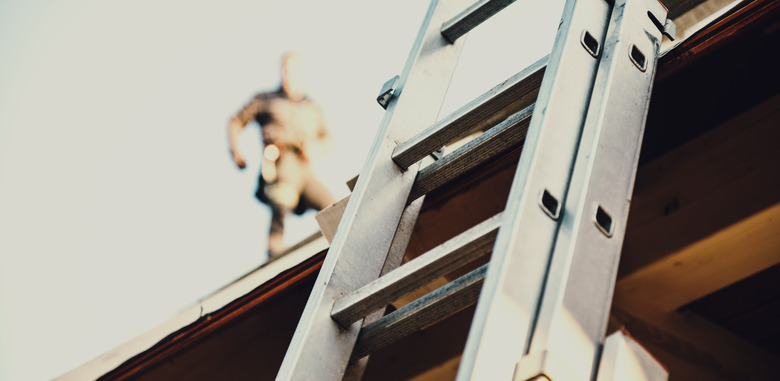How To Climb A Ladder And Walk On A Roof
Ready to tackle a roof repair? Don't reach for your extension ladder just yet. Climbing ladders and climbing on a roof come with a high potential for falls, so you want to do it right. Following basic extension ladder safety and using safety equipment can reduce your chance for injury.
Roof and Extension Ladder Safety
Roof and Extension Ladder Safety
Before you go near your ladder, you need to dress the part. Choose a pair of shoes with a strong grip on the soles to prevent slipping. Weather is also a factor. Save your ladder climbing for a dry day without high winds. Clean off leaves or other debris from the roof to reduce the risk of slipping.
Extension Ladder Setup
Extension Ladder Setup
Choose the flattest spot possible to keep your ladder stable. You want a spot that's dry and firm to keep the ladder from sinking or slipping. You can use sheets of plywood to create a level, stable base. Avoid any power lines, doors or other potential obstacles.
To set up the ladder, start with the base against the house with the ladder on the ground. You'll start at the far end away from the house, lifting and raising the ladder by moving your hands rung over rung until it's against the house. If you have a telescoping extension ladder, wait until you raise it to extend the ladder to the correct height. You want the ladder to be at least 3 feet higher than your roof line.
Reposition the base to get the correct angle. An easy way to figure the angle is to use a 1:4 ratio. In other words, for every 4 feet of ladder, you need to move the base out 1 foot from the house. If you're working with a 24-foot ladder, you want the base 6 feet from the house.
Ladder Climbing Safety
Ladder Climbing Safety
Ask a helper to hold the ladder while you climb. You should always face the ladder, holding onto the rungs while you climb. Always keep three points of contact on the ladder: Either both hands and one foot or both feet and one hand. The first time you climb the ladder, secure it with a rope or cord to an anchor point on the roof. This minimizes slipping and movement.
Transitioning to the Roof
Transitioning to the Roof
You've climbed the ladder. Now, you need to move onto the roof. Never step up and over the top of the ladder. Remember, it should extend at least 3 feet above the roof's edge. Instead, hold onto the ladder with both hands and step around the ladder and onto the roof. When you get off the roof, take the same approach, holding onto the ladder and stepping around it instead of over the top.
Roof Safety Equipment
Roof Safety Equipment
Once you're on the roof, using safety gear can prevent a serious fall. Nailing roof brackets starting at 18 inches from the eaves with additional sets of brackets every 4 feet lets you create slide guards. You need to nail these brackets into place through the roof sheathing and into the truss or rafter. Place boards on the brackets as a way to stop you from sliding off the roof or to help you regain your footing if you slip. These boards also work as a place to put tools or materials.
You can also use a roof harness that can stop you from falling off the roof. This is especially helpful on steep or high roofs. The harness attaches to a roof anchor that's secured to a truss or rafter to ensure its stability. You should only work 4 feet to the side of the anchor in either direction. That may mean you need multiple anchors. If you don't want to buy your own equipment, consider a roof safety equipment rental for a single job.
Walking on roof safety tips help you stay safe when you're inspecting your roof or handling minor repairs.
